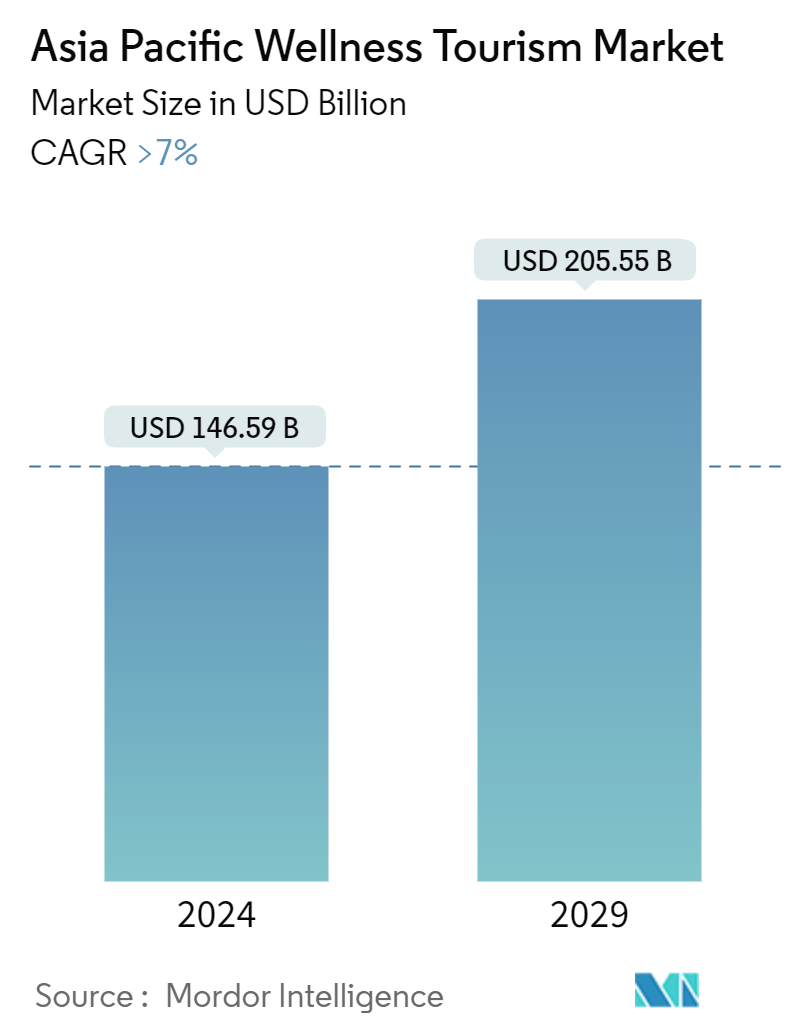Market Size of Asia Pacific Wellness Tourism Industry

| Study Period | 2020 - 2029 |
| Base Year For Estimation | 2023 |
| Market Size (2024) | USD 146.59 Billion |
| Market Size (2029) | USD 205.55 Billion |
| CAGR (2024 - 2029) | > 7.00 % |
| Market Concentration | Medium |
Major Players
*Disclaimer: Major Players sorted in no particular order |
Asia Pacific Wellness Tourism Market Analysis
The Asia Pacific Wellness Tourism Market size is estimated at USD 146.59 billion in 2024, and is expected to reach USD 205.55 billion by 2029, growing at a CAGR of greater than 7% during the forecast period (2024-2029).
Wellness tourism is a form of travel where people visit places to enhance their physical and emotional well-being. The growth of the market over the forecast period is driven by the growing interest of tourists in sectors such as healthcare, travel, and food. The customer's expenditure on various social and healthy well-being services has increased, due to factors such as an increase in disposable income, thereby anticipating market growth. The growing number of stressful lifestyles characterized by work-related stress, which will in turn favor services such as massages, yoga classes, accommodation, and boarding, are driving the wellness tourism market. To gain a competitive edge, vendors on the market are focusing on providing quality services. Competition in the market has increased as a result of the increasing number of market players offering lucrative and customized service packages targeting different consumer groups, thus favoring the interests of the consumer to choose an experiential travel experience. The market growth will then increase as a result.
COVID-19 severely impacted the overall tourism industry, and wellness tourism was no exception. During the pandemic situation, many Asian countries opted for lockdown, which stopped tourism activity. The revenue of the major players in the wellness tourism market dropped significantly due to COVID-19. Countries later started lifting lockdown restrictions, and people preferred to travel for stress relief, resulting in the recovery of revenue in the Asia-Pacific wellness tourism market.
Asia Pacific Wellness Tourism Industry Segmentation
Wellness tourism is an activity linked to maintaining or enhancing one's health and well-being. A complete background analysis of the Asia-Pacific wellness tourism market, which includes an assessment of the parental market, the report provides an overview of emerging trends in segments, significant changes in market dynamics, and a detailed analysis of the markets. The Asia-Pacific Wellness Tourism Market is segmented by travel type, which includes domestic and international; by activity, which includes in-country transport, lodging, food and beverage, shopping, activities and excursions, and other services; by travel type, which includes primary wellness travelers and secondary wellness travelers; and by geography, which includes China, India, Japan, Australia, Thailand, and other countries. The report offers market size and forecasts for the APAC wellness tourism market in terms of revenue (USD) for all the above segments.
| Travel Type | |
| Domestic | |
| International |
| Activity | |
| In-country Transport | |
| Lodging | |
| Food and Beverage | |
| Shopping | |
| Activities and Excursions | |
| Other Services |
| Travelers Type | |
| Primary Wellness Travelers | |
| Secondary Wellness Travelers |
| Geography | |
| China | |
| India | |
| Japan | |
| Australia | |
| Thailand | |
| Rest of Asia-Pacific |
Asia Pacific Wellness Tourism Market Size Summary
The Asia Pacific wellness tourism market is experiencing significant growth, driven by an increasing interest in enhancing physical and emotional well-being through travel. This sector is characterized by a rising consumer expenditure on health-related services, fueled by higher disposable incomes and a growing awareness of the benefits of wellness tourism. The market is further bolstered by the demand for stress-relief activities such as massages, yoga, and wellness-focused accommodations. The competitive landscape is marked by a surge in market players offering tailored service packages, which cater to diverse consumer preferences and enhance the appeal of experiential travel. Despite the challenges posed by the COVID-19 pandemic, which temporarily halted tourism activities, the market has shown resilience and is on a recovery path as travel restrictions are lifted and demand for stress relief travel increases.
The Asia Pacific region is a prominent destination for wellness tourism, with countries like India, Sri Lanka, South Korea, Vietnam, Nepal, and Bhutan offering unique wellness experiences. These countries are leveraging their traditional wellness practices to attract international visitors, supported by government initiatives and economic incentives to promote wellness tourism. The domestic segment, particularly in India, is witnessing growth due to the preference for local wellness facilities over international retreats. The market is consolidated, with major international hospitality players such as Accor, Hilton, Radisson, Hyatt, Marriott, and InterContinental Group holding significant market shares. Strategic partnerships, like the one between BDMS Wellness Clinic and Movenpick, are further expanding the market's reach and offerings, highlighting the ongoing evolution and potential of wellness tourism in the region.
Asia Pacific Wellness Tourism Market Size - Table of Contents
-
1. MARKET DYNAMICS AND INSIGHTS
-
1.1 Market Overview
-
1.2 Market Drivers
-
1.2.1 Increasing Focus on Personal Health and Well Being
-
1.2.2 Growing Interest in Holistic and Alternative Healing Practices
-
-
1.3 Market Restraints
-
1.3.1 High Cost Associated with Wellness Travel
-
-
1.4 Market Opportunities
-
1.4.1 Targeting Niche Markets such as Eco-wellness or Spiritual Wellness
-
1.4.2 Partnering with Local Communities and Promoting Sustainable Practices
-
-
1.5 Industry Attractiveness - Porter's Five Forces Analysis
-
1.5.1 Bargaining Power of Suppliers
-
1.5.2 Bargaining Power of Buyers
-
1.5.3 Threat of New Entrants
-
1.5.4 Threat of Substitutes
-
1.5.5 Intensity of Competitive Rivalry
-
-
1.6 Insights of Technology Innovations in the Market
-
1.7 Impact of COVID-19 on the Market
-
-
2. MARKET SEGMENTATION
-
2.1 Travel Type
-
2.1.1 Domestic
-
2.1.2 International
-
-
2.2 Activity
-
2.2.1 In-country Transport
-
2.2.2 Lodging
-
2.2.3 Food and Beverage
-
2.2.4 Shopping
-
2.2.5 Activities and Excursions
-
2.2.6 Other Services
-
-
2.3 Travelers Type
-
2.3.1 Primary Wellness Travelers
-
2.3.2 Secondary Wellness Travelers
-
-
2.4 Geography
-
2.4.1 China
-
2.4.2 India
-
2.4.3 Japan
-
2.4.4 Australia
-
2.4.5 Thailand
-
2.4.6 Rest of Asia-Pacific
-
-
Asia Pacific Wellness Tourism Market Size FAQs
How big is the Asia Pacific Wellness Tourism Market?
The Asia Pacific Wellness Tourism Market size is expected to reach USD 146.59 billion in 2024 and grow at a CAGR of greater than 7% to reach USD 205.55 billion by 2029.
What is the current Asia Pacific Wellness Tourism Market size?
In 2024, the Asia Pacific Wellness Tourism Market size is expected to reach USD 146.59 billion.

